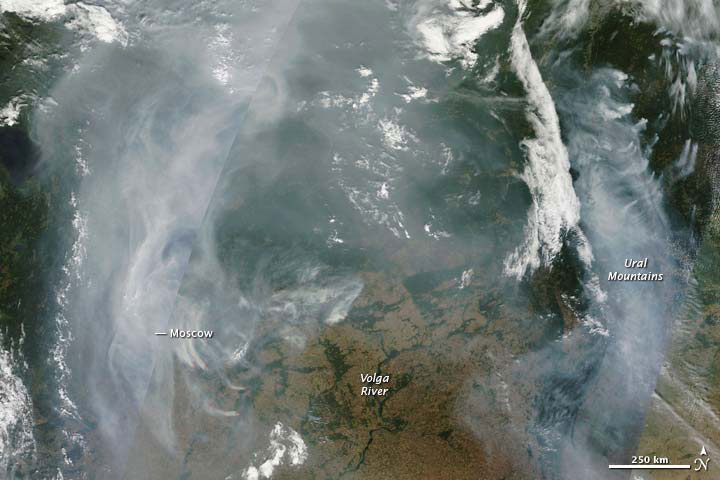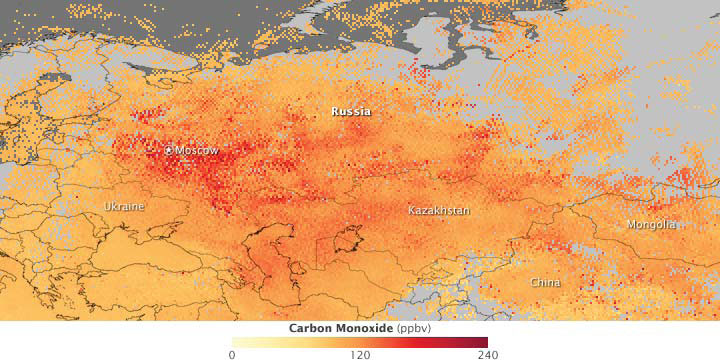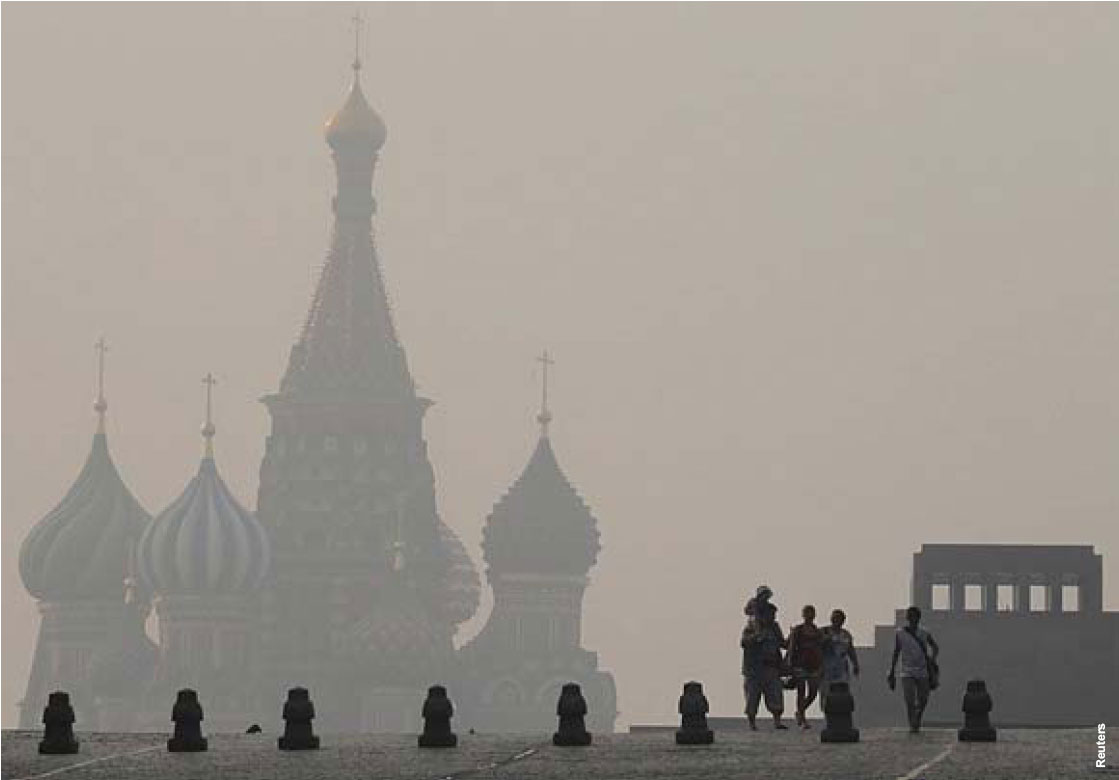|
Having trouble reading this email? Download the PDF.

Thematic Focus: Resource Efficiency, Harmful Substances and Hazardous Waste,
Disasters and Conflicts,Environmental Governance, and Ecosystem Management
Satellite images record how wildfires have destroyed one million hectares of forests in western Russia
Why is this issue important?
Some types of forest ecosystems in Russia are
adapted to wildfires and fire-tolerant trees such as pine
(Pinus) can withstand high temperatures. Such forests
regenerate quickly after fires have swept through.
The summer of 2010 was the hottest in Russia in 130
years, however, and frequent temperatures as high
as 40°C dried trees that are not fire-tolerant (such
as birch), other vegetation, and peat bogs, making
them a fire hazard. The heat wave began in June,
and by August, fires started by lightning or careless
human activity had burned more than 15 million ha of
vegetation, including forests and crops (Gilbert 2010).
Heat waves and forest fi res can also destroy crops:
Russia produces about eight per cent of the world’s
wheat (Hernandez and others 2010), so any threat
to its harvest has global repercussions. In addition,smoke, ash and dangerous gases from wildfires affect
air quality, with impacts on human health, while forest
fi res can consume homes and other infrastructure and
cause human casualties.
Why are the findings and implications?
Recent satellite images show that the summer fires
in 2010 destroyed more than one million hectares
of forests in western Russia alone and harmed
approximately 40 000 ha of protected forest area
(UNEP 2010). At one point, states of emergency were
in effect in 14 regions in Russia. Forest fires in the
western region around Moscow (Figures 1) produced
smoke, dust, and dangerous gases that polluted the
air; in some places, carbon monoxide was 10 times the
permitted maximum (Figure 2). At least 53 people have
died and 806 have needed medical attention. Houses have burned and harvests have been lost—including
some 10 million hectares of grain (Gilbert 2010).
Figure 1: Extensive forest fires in the western region around Moscow and in the Ural region produce clearly visible smoke
clouds larger than 1 000 km in extent (Source: NASA 2010).


Figure 2: Carbon monoxide concentrations in the atmosphere between 2 and 8 km above Russia as recorded from 1 to 8 August
2010 by NASA (MOPITT). Ground concentrations of this dangerous gas are reported to be much higher, causing people to
report headaches, dizziness, and other more serious conditions.
|
|

Figure 3: The forest fires near Moscow cover the Red Square in smoke and ash
|
The recent drought and associated fires destroyed
20 per cent of Russia’s wheat crop, which represents
a 1.6 per cent decline in the global wheat supply
The Russian meteorological agency has noted
that the number of dangerous climate events,
including heat waves, has doubled over the past
15 years (InfoRussia EU 2010). Climate change
and increased climate variability could make such
wildfi res more common and extend their spread
(UNEP 2010). Some areas could also continue to
dry out, preventing forests from growing back and
leading to the encroachment of grasslands, which
are more vulnerable to wildfires. New legislation in
2007 making local regions responsible for forest
management, and the lack of capacity of these
agencies to protect forests and peat lands may have
had a role in the fire severity (WWF 2010).
(Gilbert 2010). As a result, Russia froze the export
of grain, including wheat, barley, rye and corn, from
15 August to 31 December 2010. Forecasts suggest
a 38 per cent decline in the 2010 harvest compared
to 2009 (Hernandez and others 2010), with likely
implications for food security in some regions.
References
Gilbert, N. (2010). Russia counts environmental cost of wildfires. Nature News, 12 August. http://www.nature.com/
(Accessed on August 23, 2010)
Hernandez, M., Robles, M., Torero, M. (2010). Fires in Russia, Wheat Production, and Volatile Markets: Reasons to Panic? IFPRI
6 August 2010. http://www.fire.uni-freiburg.de/ (Accessed on August 23, 2010)
InfoRussia EU. (2010). RIS Novosti – Russia may have to import 5 m tons of grain in 2010-2011. InfoRussia EU, 19 August.
http://www.inforusia.eu/ (Accessed on August 23, 2010)
NASA. (2010). Smoke over Western Russia : Natural Hazards. http://earthobservatory.nasa.gov/ (Accessed August 11, 2010).
UNEP. (2010). Russian forest fires pose major threat to bats. UNEP News Centre, 18 August. http://www.unep.org/
(Accessed on August 23, 2010)
WWF. (2010). Wildfires, bad forest laws linked in Russia. WWF News, 2 August.
http://www.wwf.ru/ (Accessed on August 23, 2010)
Information is regularly scanned, screened, filtered, carefully edited, and published for
educational purposes. UNEP does not accept any liability or responsibility for the accuracy, completeness, or any other quality of information and
data published or linked to the site. Please read our privacy policy and
disclaimer for further information.
|








